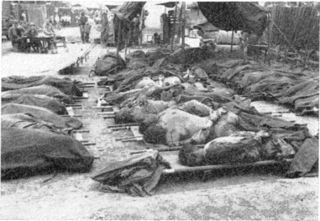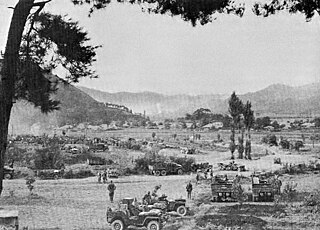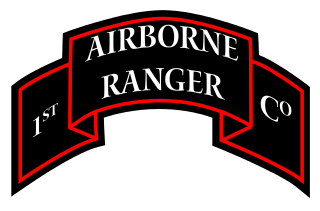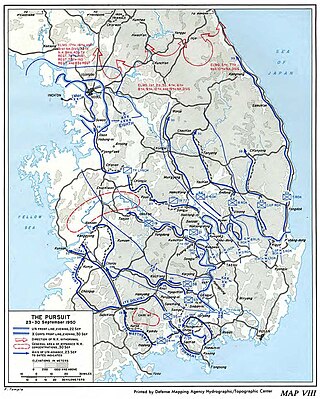
The Battle of the Pusan Perimeter, known in Korean as the Battle of the Naktong River Defense Line, was a large-scale battle between United Nations Command (UN) and North Korean forces lasting from August 4 to September 18, 1950. It was one of the first major engagements of the Korean War. An army of 140,000 UN troops, having been pushed south to the brink of defeat, were rallied to make a final stand against the invading Korean People's Army (KPA), 98,000 men strong.

The Battle of the Ch'ongch'on River, also known as the Battle of the Ch'ongch'on, was a decisive battle in the Korean War, and it took place from November 25 to December 2, 1950, along the Ch'ongch'on River Valley in the northwestern part of North Korea. In response to the successful Chinese First Phase Campaign against the United Nations (UN) forces, General Douglas MacArthur launched the Home-by-Christmas Offensive to expel the Chinese forces from Korea and to end the war. Anticipating this reaction, the Chinese People's Volunteer Army (PVA) Commander Peng Dehuai planned a counteroffensive, dubbed the "Second Phase Campaign", against the advancing UN forces.
The Battle of the Notch was an engagement between United States and North Korean forces early in the Korean War on August 2, 1950 in southern South Korea. The fight ended in a victory for the United States after North Korean forces attempting to assault the US position were blocked and repelled repeatedly, suffering heavy casualties.

The Battle of Taegu was an engagement between United Nations Command (UN) and North Korean forces early in the Korean War, with fighting continuing from August 5–20, 1950 around the city of Taegu, South Korea. It was a part of the Battle of Pusan Perimeter, and was one of several large engagements fought simultaneously. The battle ended in a victory for the UN after their forces were able to drive off an offensive by Korean People's Army (KPA) divisions attempting to cross the Naktong River and assault the city.

The Hill 303 massacre was a war crime that took place during the opening days of the Korean War on August 17, 1950, on a hill above Waegwan, Republic of Korea. Forty-one United States Army (US) prisoners of war were murdered by troops of the North Korean People's Army (KPA) during one of the engagements of the Battle of Pusan Perimeter.

In the Battle of the Bowling Alley , United Nations Command (UN) forces defeated North Korean forces early in the Korean War near the city of Taegu, South Korea. The battle took place in a narrow valley, dubbed the "Bowling Alley", which was north of Taegu. It followed a week of fighting between the Korean People's Army (KPA) 13th Division and the Republic of Korea Army's (ROK) 1st Division along the latter's last defensible line in the hills north of the city. Reinforcements, including the US Army's 27th and 23rd Infantry Regiments were committed to bolster the ROK defenses. This battle and several others were smaller engagements of the Battle of Pusan Perimeter.

The Battle of Yongdong was an engagement between United States and North Korean forces early in the Korean War. It occurred on July 22–25, 1950, in the village of Yongdong in southern South Korea. The newly arrived US Army 1st Cavalry Division was ordered there to cover the retreat of the US 24th Infantry Division after the Battle of Taejon. The 1st Cavalry Division soldiers, however, were untried in combat, and the North Korean Korean People's Army's (KPA) 3rd Division was able to outmaneuver them and force them back.
The Battle of Hwanggan was an engagement between United States and North Korean forces that took place on July 23–29, 1950, on a road north of the village of Hwanggan in southern South Korea, early in the Korean War. The battle ended in a victory for the North Koreans after US troops were forced to withdraw south.

The Battle of Masan was an engagement between United Nations Command (UN) and North Korean forces, which took place early in the Korean War between August 5 and September 19, 1950, in the vicinity of Masan and the Naktong River in South Korea. It was part of the Battle of Pusan Perimeter, and was one of several large engagements fought simultaneously. The battle ended in a victory for the UN after large numbers of United States Army (US) troops were able to repel the repeated attacks of two Korean People's Army (KPA) divisions.

The Battle of Battle Mountain was an engagement between United Nations Command (UN) and North Korean forces early in the Korean War from August 15 to September 19, 1950, on and around the Sobuk-san mountain area in South Korea. It was one of several large engagements fought simultaneously during the Battle of Pusan Perimeter. The battle ended in a victory for the UN after large numbers of United States Army (US) and Republic of Korea Army (ROK) troops were able to prevent a Korean People's Army (KPA) division from capturing the mountain area.

The Battle of Nam River was an engagement between the United Nations Command (UN) and North Korean forces early in the Korean War from August 31 to September 19, 1950, in the vicinity of the Nam River and the Naktong River in South Korea. It was a part of the Battle of Pusan Perimeter, and was one of several large engagements fought simultaneously. The battle ended in a victory for the United Nations after United States Army (US) troops repelled a Korean People's Army (KPA). attack across the river.

The Great Naktong Offensive was a North Korean military offensive against United Nations Command (UN) forces early in the Korean War, taking place from September 1–15, 1950. It was the North Korean Korean People's Army (KPA)'s unsuccessful final bid to break the Pusan Perimeter established by the UN forces.

The Battle of Kyongju was an engagement between United Nations Command (UN) and North Korean forces early in the Korean War from August 31 to September 15, 1950, in the vicinity of Kyongju in South Korea. It was a part of the Battle of Pusan Perimeter, and was one of several large engagements fought simultaneously. The battle ended in a victory for the UN after large numbers of United States Army (US) and Republic of Korea Army (ROK) troops repelled a strong North Korean Korean People's Army (KPA) attack.

The Battle of Ka-san was an engagement between United Nations Command (UN) and North Korean forces early in the Korean War from September 1 to September 15, 1950, in the vicinity of Ka-san , Chilgok County in South Korea. It was a part of the Battle of Pusan Perimeter, and was one of several large engagements fought simultaneously. The battle ended in a victory for the United Nations after large numbers of United States Army (US) and Republic of Korea Army (ROK) troops repelled a strong Korean People's Army (KPA) attack.

The Second Battle of Naktong Bulge was an engagement between United Nations Command (UN) and North Korean forces early in the Korean War from September 1 to September 15, 1950, along the Naktong River in South Korea. It was a part of the Battle of Pusan Perimeter, and was one of several large engagements fought simultaneously. The battle ended in a victory for the United Nations after large numbers of United States Army (US) troops repelled a strong Korean People's Army (KPA) attack.

The Battle of Yongsan was an engagement between United Nations Command (UN) and North Korean forces early in the Korean War from September 1–5, 1950, at Yongsan in South Korea. It was part of the Battle of Pusan Perimeter and was one of several large engagements fought simultaneously. The battle ended in a victory for the UN after large numbers of United States Army (US) repelled a strong Korean People's Army (KPA) attack.

The 1st Ranger Infantry Company (Airborne) was a Ranger light infantry company of the United States Army active during the Korean War. As a small special forces unit, it specialized in irregular warfare.

The 2nd Ranger Infantry Company (Airborne) was a Ranger light infantry company of the United States Army active during the Korean War. As a small special operations unit, it specialized in irregular warfare. A segregated unit, all of its personnel, including its officers, were African-Americans.

The 3rd Ranger Infantry Company (Airborne) was a Ranger light infantry company of the United States Army active during the Korean War. As a small special forces unit, it specialized in irregular warfare.

The UN Forces September 1950 counteroffensive was a large-scale offensive by United Nations Command (UN) forces against North Korean forces commencing on 23 September 1950.






















